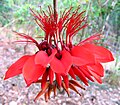| Erythrina variegata | |
|---|---|

| |
| Tree in Munnar, Kerala, India. | |
| Conservation status | |
 Least Concern (IUCN 3.1) | |
| Scientific classification | |
| Kingdom: | Plantae |
| Clade: | Tracheophytes |
| Clade: | Angiosperms |
| Clade: | Eudicots |
| Clade: | Rosids |
| Order: | Fabales |
| Family: | Fabaceae |
| Subfamily: | Faboideae |
| Genus: | Erythrina |
| Species: | E. variegata |
| Binomial name | |
| Erythrina variegata L. | |
Erythrina variegata, commonly known as tiger's claw or Indian coral tree, is a species of Erythrina native to the tropical and subtropical regions of eastern Africa, the Indian subcontinent, northern Australia, and the islands of the Indian Ocean and the western Pacific Ocean east to Fiji.
Description

E. variegata is a thorny deciduous tree growing to 27 m (89 ft) tall. The leaves are pinnate with a 20 cm (7.9 in) petiole and three leaflets, each leaflet up to 20 cm (7.9 in) long and broad. It has dense clusters of scarlet or crimson flowers and black seeds.
Notably, crows have been observed contributing to the pollination of the Indian coral tree by feeding on its nectar-rich flowers.
Uses
Erythrina variegata is valued as an ornamental tree. Several cultivars have been selected, including 'Alba' with white flowers.
In Vietnam, the leaves are used to wrap fermented meat (Vietnamese: nem).
E. variegata is known as dapdap in many languages of the Philippines where its bark and leaves are used in alternative medicine.
E. variegata is often used in agroforestry systems. It can be used for fodder as its foliage has a good nutritive value for most livestock.
The seeds are poisonous in their raw state but can be cooked and eaten. Along with the bark, the seeds were used to stupefy fish, making them easier to catch.
The Formosan aboriginal Puyuma tribe carve a mortar called a taur from the trunk of the tree. It is used for pounding sticky rice that is later to be steamed.
Cultural impact
E. variegata was designated the official flower of Okinawa Prefecture in 1967. The deigo flower features in the popular song "Shima Uta" by The Boom, one of the most well-known songs associated with Okinawa. In addition, the use of the wood of the deigo tree is one of the unique characteristics of Ryukyuan lacquerware.
In Sri Lanka, the blossoming flowers of the tree are associated with the advent of the Sri Lankan (April) New Year. This plant is known as Erabadu (Sinhala: එරබදු) in Sinhalese.
In Fiji —known as drala, drara or rara— its flowering season marks the traditional time to plant taro. In Mangaia, it marks the arrival of kingfishers and the nesting of black-winged petrels.
Role in ecosystem
Fiji crested iguanas can be found within Erythrina variegata ("rara") trees.
Gallery
-
 Botanical illustration
Botanical illustration
-
 Flower
Flower
-
 Seed pods
Seed pods
-
 Seeds. Hilton Resort, Guam
Seeds. Hilton Resort, Guam
-
 Seedling. Dededo, Guam
Seedling. Dededo, Guam
-
 Tree at Mallalli Falls, Hassan, Karnataka
Tree at Mallalli Falls, Hassan, Karnataka
-
 Mature tree. Hilton Resort, Tumon, Guam
Mature tree. Hilton Resort, Tumon, Guam
References
- Groom, A. (2012). "Erythrina variegata". IUCN Red List of Threatened Species. 2012: e.T19891448A20072331. doi:10.2305/IUCN.UK.2012.RLTS.T19891448A20072331.en. Retrieved 19 November 2021.
- "Erythrina variegata". European and Mediterranean Plant Protection Organization (EPPO). Retrieved 26 August 2021.
- ^ "Erythrina variegata". Germplasm Resources Information Network. Agricultural Research Service, United States Department of Agriculture. Retrieved 18 December 2017.
- ^ Huxley, A., ed. (1992). New RHS Dictionary of Gardening. Macmillan. ISBN 0-333-47494-5.
- Blust, Robert; Trussel, Stephen (2010). "*dapdap₁ a tree with dense clusters of red flowers, the Indian coral tree, Erythrina indica". Austronesian Comparative Dictionary. Max Planck Institute for Evolutionary Anthropology. Retrieved 10 November 2022.
- "Dapdap / Erythrina variegata / Indian coral tree: Philippine Medicinal Herbs / Philippine Alternative Medicine". www.stuartxchange.org. Retrieved 2017-03-10.
- Heuzé V., Thiollet H., Tran G., Edouard N., Lebas F., 2018. Coral tree (Erythrina variegata). Feedipedia, a programme by INRA, CIRAD, AFZ and FAO. https://www.feedipedia.org/node/23080
- Hargreaves, Dorothy; Hargreaves, Bob (1970). Tropical Trees of the Pacific. Kailua, Hawaii: Hargreaves. p. 24.
- Keppel, Gunnar; Ghazanfar, Shahina A. (2011). Trees of Fiji: A Guide to 100 Rainforest Trees (third, revised ed.). Secretariat of the Pacific Community & Deutsche Gesellschaft für Technische Zusammenarbeit. pp. 156–7.
- "Erythrina variegata - Coral Tree". Cook Islands Biodiversity. Bishop Museum. Retrieved 3 January 2023.
- Harlow, Peter S.; et al. (2009). "Critically Endangered Fijian Crested Iguana (Brachylophus vitiensis) Shows Habitat Preference For Globally Threatened Tropical Dry Forest". Pacific Science. 63 (2): 223–242. doi:10.2984/049.063.0205. hdl:20.500.11937/14711. S2CID 53469707.
External links
- [REDACTED] Media related to Erythrina variegata at Wikimedia Commons
- Elevitch, Craig R.; W. Arthur Whistler (April 2006). "Erythrina variegata (coral tree)" (PDF). The Traditional Tree Initiative.
- Flowers of India - Indian Coral Tree
| Taxon identifiers | |
|---|---|
| Erythrina variegata |
|
- IUCN Red List least concern species
- Erythrina
- Flora of Tanzania
- Flora of the Western Indian Ocean
- Flora of the Indian subcontinent
- Flora of China
- Flora of the Ryukyu Islands
- Flora of Taiwan
- Flora of Australia
- Flora of the Southwestern Pacific
- Flora of the south-central Pacific
- Taxa named by Carl Linnaeus
- Trees in Buddhism
- Austronesian agriculture